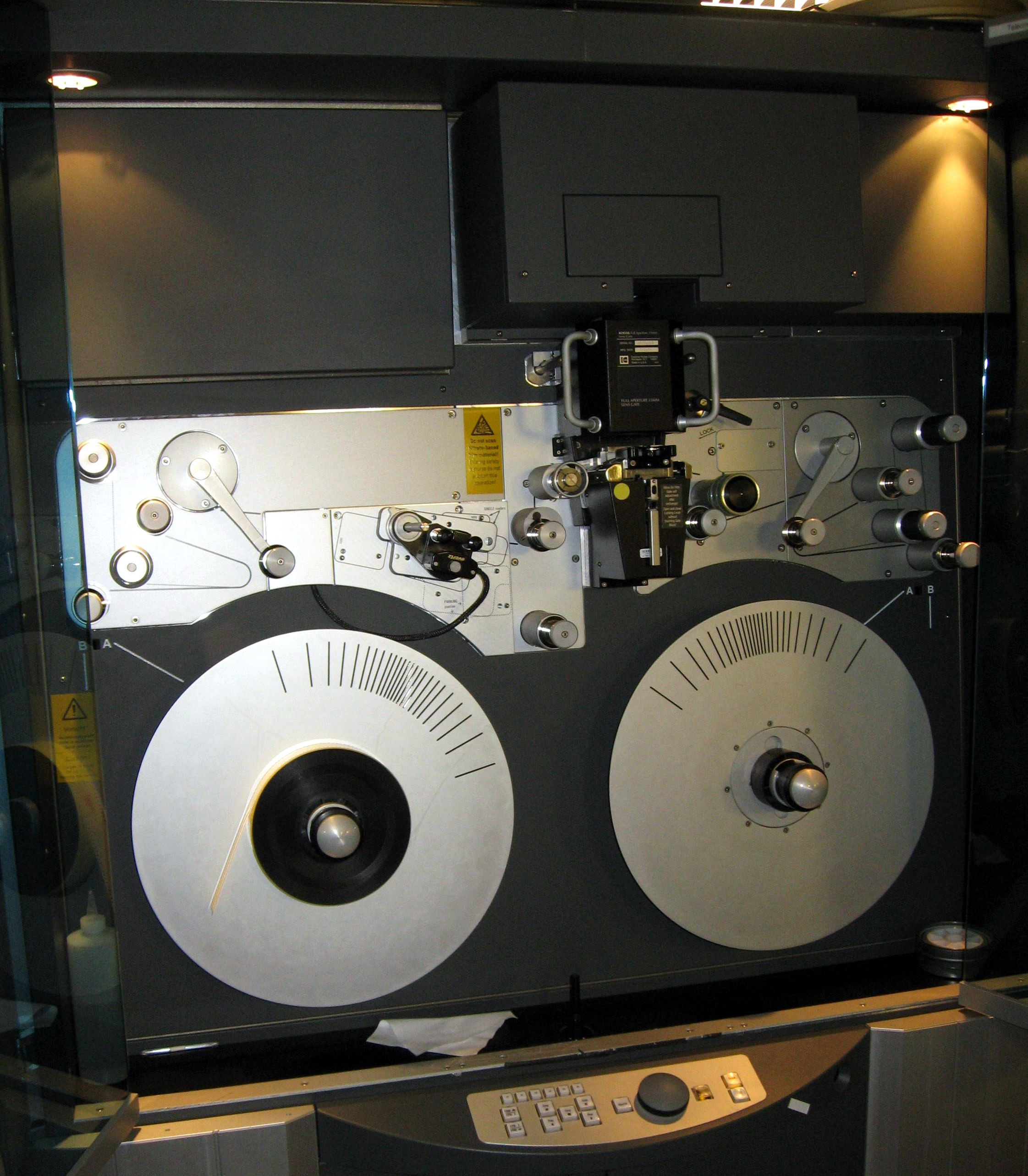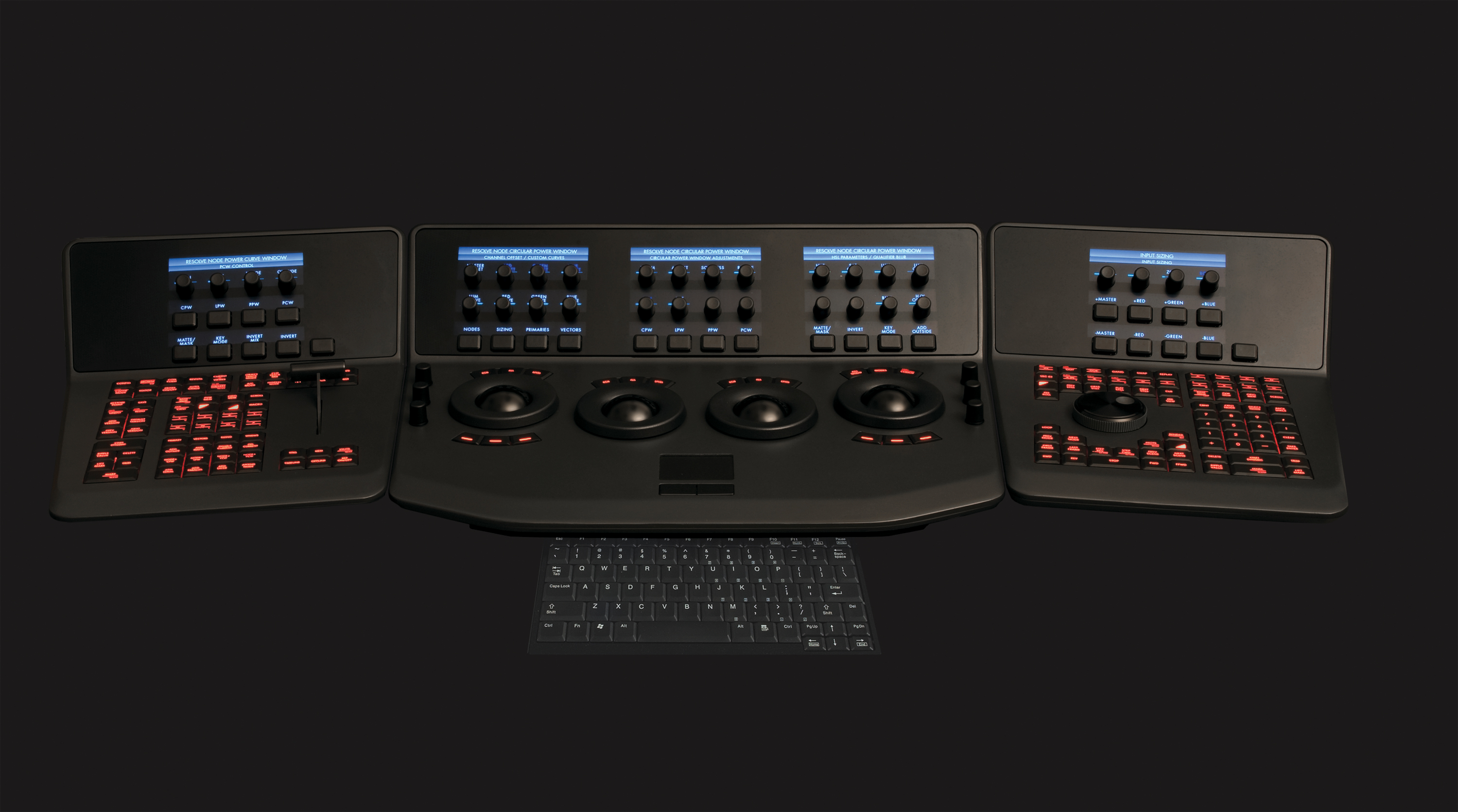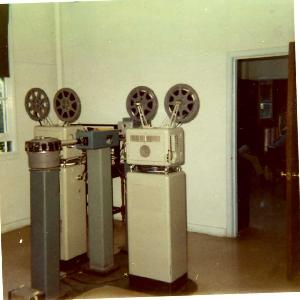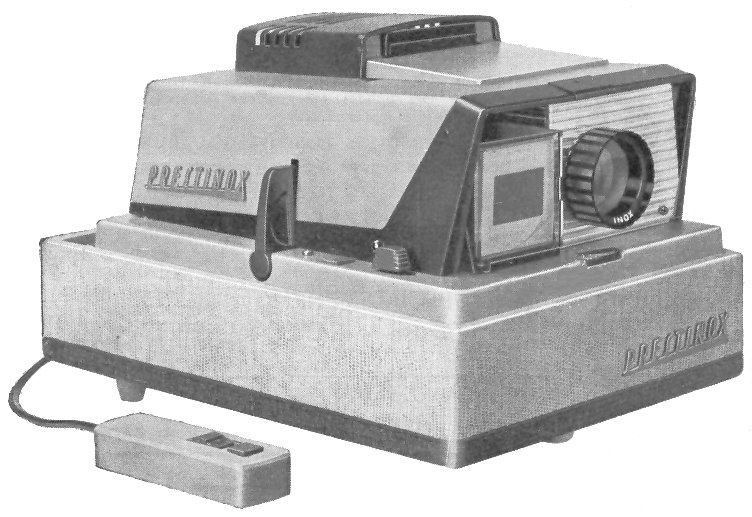|
Telecine
Telecine ( or ) is the process of transferring film into video and is performed in a color suite. The term is also used to refer to the equipment used in the post-production process. Telecine enables a motion picture, captured originally on film stock, to be viewed with standard video equipment, such as television sets, video cassette recorders (VCR), DVD, Blu-ray Disc or computers. Initially, this allowed television broadcasters to produce programs using film, usually 16mm stock, but transmit them in the same format, and quality, as other forms of television production. Furthermore, telecine allows film producers, television producers and film distributors working in the film industry to release their productions on video and allows producers to use video production equipment to complete their filmmaking projects. Within the film industry, it is also referred to as a TK, because TC is already used to designate timecode. Motion picture film scanners are similar to telecines. ... [...More Info...] [...Related Items...] OR: [Wikipedia] [Google] [Baidu] |
Motion Picture Film Scanner
A motion picture film scanner is a device used in digital filmmaking to scan original film for storage as high-resolution digital intermediate files. A film scanner scans original film stock: negative or positive print or reversal/IP. Units may scan gauges from 8 mm to 70 mm (8 mm, Super 8, 9.5 mm, 16 mm, Super 16, 35 mm, Super 35, 65 mm and 70 mm) with very high resolution scanning at 2K, 4K, 8K, or 16K resolutions. (2K is approximately 2048×1080 pixels and 4K is approximately 4096×2160 pixels). Some models of film scanner are intermittent pull-down film scanners which scan each frame individually, locked down in a pin-registered film gate, taking roughly a second per frame. Continuous-scan film scanners, where the film frames are scanned as the film is continuously moved past the imaging pick up device, are typically evolved from earlier telecine mechanisms, and can act as such at lower resolutions. The scanner scans ... [...More Info...] [...Related Items...] OR: [Wikipedia] [Google] [Baidu] |
Color Suite
A color suite (also called a color bay, telecine suite, or color correction bay) is the control room for color grading video in a post-production environment. Technology and specifications The video source could be from: a telecine, a video tape recorder (VTR), a motion picture film scanner, virtual telecine or a Direct to Disk Recording (DDR) or the older system called a film chain. A high end broadcast color suite may use a Da Vinci Systems or Pandora International color corrector. If a VTR is the source for the video the room is often called a ''tape to tape'' suite. Many suites are designed to operate as a telecine suite or a tape to tape suite by changing the configuration of the suite. The operator of the suite is usually called a ''Colorist''. If a telecine is the source this is called a ''Film to Tape'' operation. A color suite may use one video standard or be able to change configuration to a number of standards like: high-definition video, NTSC, or PAL or a DI workflow. C ... [...More Info...] [...Related Items...] OR: [Wikipedia] [Google] [Baidu] |
Film Chain
A film chain or film island is a television – professional video camera with one or more projectors aligned into the photographic lens of the camera. With two or more projectors a system of front-surface mirrors that can pop-up are used in a multiplexer. These mirrors switch different projectors into the camera lens. The camera could be fed live to air for broadcasting through a vision mixer or recorded to a VTR for post-production or later broadcast. In most TV use this has been replaced by a telecine. Projectors The projectors often are: 16 mm film movie projector, a 35 mm slide projector and a 35 mm film movie projector. In low-end use the motion picture 35 mm projector would be replaced by a second 16 mm projector or 8 mm film, or Super 8 mm film or Single-8 projector. The multiplexer with the camera and projectors surrounding it would often be called a ''film island''. The optical or mag or magnetic strip soundtrack on the motion picture would be pick ... [...More Info...] [...Related Items...] OR: [Wikipedia] [Google] [Baidu] |
NTSC
The first American standard for analog television broadcast was developed by National Television System Committee (NTSC)National Television System Committee (1951–1953), Report and Reports of Panel No. 11, 11-A, 12–19, with Some supplementary references cited in the Reports, and the Petition for adoption of transmission standards for color television before the Federal Communications Commission, n.p., 1953], 17 v. illus., diagrs., tables. 28 cm. LC Control No.:5402138Library of Congress Online Catalog/ref> in 1941. In 1961, it was assigned the designation CCIR System M, System M. In 1953, a second NTSC standard was adopted, which allowed for color television broadcast compatible with the existing stock of black-and-white receivers. It is one of three major color formats for analog television, the others being PAL and SECAM. NTSC color is usually associated with the System M. The only other broadcast television system to use NTSC color was the System J. Since the introdu ... [...More Info...] [...Related Items...] OR: [Wikipedia] [Google] [Baidu] |
Video
Video is an electronic medium for the recording, copying, playback, broadcasting, and display of moving visual media. Video was first developed for mechanical television systems, which were quickly replaced by cathode-ray tube (CRT) systems which, in turn, were replaced by flat panel displays of several types. Video systems vary in display resolution, aspect ratio, refresh rate, color capabilities and other qualities. Analog and digital variants exist and can be carried on a variety of media, including radio broadcast, magnetic tape, optical discs, computer files, and network streaming. History Analog video Video technology was first developed for mechanical television systems, which were quickly replaced by cathode-ray tube (CRT) television systems, but several new technologies for video display devices have since been invented. Video was originally exclusively a live technology. Charles Ginsburg led an Ampex research team developing one of the first practical vi ... [...More Info...] [...Related Items...] OR: [Wikipedia] [Google] [Baidu] |
Interlaced Video
Interlaced video (also known as interlaced scan) is a technique for doubling the perceived frame rate of a video display without consuming extra bandwidth. The interlaced signal contains two fields of a video frame captured consecutively. This enhances motion perception to the viewer, and reduces flicker by taking advantage of the phi phenomenon. This effectively doubles the time resolution (also called ''temporal resolution'') as compared to non-interlaced footage (for frame rates equal to field rates). Interlaced signals require a display that is natively capable of showing the individual fields in a sequential order. CRT displays and ALiS plasma displays are made for displaying interlaced signals. Interlaced scan refers to one of two common methods for "painting" a video image on an electronic display screen (the other being progressive scan) by scanning or displaying each line or row of pixels. This technique uses two fields to create a frame. One field contains all od ... [...More Info...] [...Related Items...] OR: [Wikipedia] [Google] [Baidu] |
Spirit Datacine 4k Doors Open
Spirit or spirits may refer to: Liquor and other volatile liquids * Spirits, a.k.a. liquor, distilled alcoholic drinks * Spirit or tincture, an extract of plant or animal material dissolved in ethanol * Volatile (especially flammable) liquids, such as ** Ethanol, also known as drinking alcohol ** Gasoline (or petrol), a clear petroleum-derived flammable liquid that is used primarily as a fuel ** Petroleum ether, liquid hydrocarbon mixtures used chiefly as non-polar solvents ** White spirit or mineral spirits, a common organic solvent used in painting and decorating Spirituality and mood * Spirituality, pertaining to the soul or spirit *Spirit (vital essence), the non-corporeal essence of a being or entity **Vitalism, a belief in some fundamental, non-physical essence which differentiates organisms from inanimate, material objects **''Pneuma'', an ancient Greek word for 'breath' or 'wind', but also 'spirit' or 'soul' ** Soul, the spiritual part of a living being, often regarde ... [...More Info...] [...Related Items...] OR: [Wikipedia] [Google] [Baidu] |
Video Tape
Videotape is magnetic tape used for storing video and usually sound in addition. Information stored can be in the form of either an analog or digital signal. Videotape is used in both video tape recorders (VTRs) and, more commonly, videocassette recorders (VCRs) and camcorders. Videotapes have also been used for storing scientific or medical data, such as the data produced by an electrocardiogram. Because video signals have a very high bandwidth, and stationary heads would require extremely high tape speeds, in most cases, a helical-scan video head rotates against the moving tape to record the data in two dimensions. Tape is a linear method of storing information and thus imposes delays to access a portion of the tape that is not already against the heads. The early 2000s saw the introduction and rise to prominence of high-quality random-access video recording media such as hard disks and flash memory. Since then, videotape has been increasingly relegated to archival and simi ... [...More Info...] [...Related Items...] OR: [Wikipedia] [Google] [Baidu] |
Home Movies
A home movie is a short amateur film or video typically made just to preserve a visual record of family activities, a vacation, or a special event, and intended for viewing at home by family and friends. Originally, home movies were made on photographic film in formats that usually limited the movie-maker to about three minutes per roll of costly camera film. The vast majority of amateur film formats lacked audio, shooting silent film. The 1970s saw the advent of consumer camcorders that could record an hour or two of video on one relatively inexpensive videocassette which also had audio and did not need to be developed the way film did. This was followed by digital video cameras that recorded to flash memory, and most recently smartphones with video recording capability, made the creation of home movies easier and much more affordable to the average person. The technological boundaries between home-movie-making and professional movie-making are becoming increasingly blurred ... [...More Info...] [...Related Items...] OR: [Wikipedia] [Google] [Baidu] |
Field (video)
In video, a field is one of the many still images which are displayed sequentially to create the impression of motion on the screen. Two fields comprise one video frame. When the fields are displayed on a video monitor they are "interlaced" so that the content of one field will be used on all of the odd-numbered lines on the screen and the other field will be displayed on the even lines. Converting fields to a still frame image requires a process called deinterlacing, in which the missing lines are duplicated or interpolated to recreate the information that would have been contained in the discarded field. Since each field contains only half of the information of a full frame, however, deinterlaced images do not have the resolution of a full frame. In order to increase the resolution of video images, therefore, new schemes have been created that capture full-frame images for each frame. Video composed of such frames is called progressive scan video. Video shot with a standard vi ... [...More Info...] [...Related Items...] OR: [Wikipedia] [Google] [Baidu] |
Slide Projector
A slide projector is an opto-mechanical device for showing photographic slides. 35 mm slide projectors, direct descendants of the larger-format magic lantern, first came into widespread use during the 1950s as a form of occasional home entertainment; family members and friends would gather to view slide shows. Reversal film was much in use, and supplied slides snapped during vacations and at family events. Slide projectors were also widely used in educational and other institutional settings. Photographic film slides and projectors have mostly been replaced by image files on digital storage media shown on a projection screen by using a video projector or simply displayed on a large-screen video monitor. History A continuous-slide lantern was patented in 1881. It included a dissolving views apparatus.Sloane, T. O'Conor. ''Facts Worth Knowing Selected Mainly from the Scientific American for Household, Workshop, and Farm Embracing Practical and Useful Information fo ... [...More Info...] [...Related Items...] OR: [Wikipedia] [Google] [Baidu] |
Kinescope
Kinescope , shortened to kine , also known as telerecording in Britain, is a recording of a television program on motion picture film, directly through a lens focused on the screen of a video monitor. The process was pioneered during the 1940s for the preservation, re-broadcasting and sale of television programmes before the introduction of quadruplex videotape, which from 1956 eventually superseded the use of kinescopes for all of these purposes. Kinescopes were the only practical way to preserve live television broadcasts prior to videotape. Typically, the term Kinescope can refer to the process itself, the equipment used for the procedure (a movie camera mounted in front of a video monitor, and synchronized to the monitor's scanning rate), or a film made using the process. The term originally referred to the cathode ray tube used in television receivers, as named by inventor Vladimir K. Zworykin in 1929. Hence, the recordings were known in full as kinescope films or kines ... [...More Info...] [...Related Items...] OR: [Wikipedia] [Google] [Baidu] |







